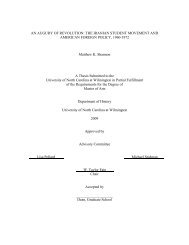Saprolegnia - The iLumina Digital Library
Saprolegnia - The iLumina Digital Library
Saprolegnia - The iLumina Digital Library
Create successful ePaper yourself
Turn your PDF publications into a flip-book with our unique Google optimized e-Paper software.
and tuberculate projections. Oogonial stalks ( 1 / 2 -) 1-1 1 / 2 (-3) times the diameter of the<br />
oogonium in length; straight, branched, unbranched, or irregular. Oospores subcentric;<br />
spherical or subspherical; 1-2 (-6) per oogonium and usually not filling it; (17-) 26-33<br />
(-44) µm in diameter; germination not observed. Antheridial branches predominantly<br />
androgynous, rarely monoclinous, very rarely diclinous; sometimes arising in a<br />
clustered fashion below the oogonium; unbranched or branched, usually irregular in<br />
general configuration; persisting. Antheridial cells simple; short-clavate or tuberous;<br />
apically or laterally appressed; persisting; fertilization tubes present or absent, not<br />
persisting.<br />
<strong>The</strong> densely papillate oogonia that generally contain only one or two subcentric<br />
oospores (Fig. 92 B, C, E) make this species easily identifiable. In gross culture,<br />
specimens sometimes can be recognized by reason of the very diffuse, flaccid nature of<br />
the mycelium.<br />
Dick (1969a) placed this species in Scoliolegnia, a genus that we do not recognize.<br />
An unusual “form” of <strong>Saprolegnia</strong> asterophora first described by Dick in 1960(c) later was<br />
placed by him (1969a) in Scoliolegnia and renamed Scoliolegnia subeccentrica. We<br />
recognize Dick’s species as a valid taxon of <strong>Saprolegnia</strong>.<br />
Of the three taxa that Dick (1969a) considered to be an aggregate species --<br />
Scoliolegnia (=<strong>Saprolegnia</strong>) asterophora, S. subeccentrica, and S. blelhamensis -- only S.<br />
asterophora has subcentric oospores. With respect to the nature and density of its<br />
oogonium wall ornamentations, S. asterophora (Fig. 92 B) very closely approaches S.<br />
subeccentrica (Fig. 92 N, O).<br />
CONFIRMED RECORDS: -- BRITISH ISLES: Dick (loc. cit.); Forbes<br />
(1935b:7, fig. 2a-f). CANADA: Maestres (1977:150, figs. 46, 47). CZECHOSLOVAKIA:<br />
Cejp (1959a:253,1 fig. 96) DENMARK: Petersen (1909a: fig. 3h; 1910: fig. 3h). FINLAND:<br />
Häyrén (1927:50). GERMANY: de Bary (loc. cit.; 1881:269 et sqq., pl. 6, figs. 18-29;<br />
1888:614); A. Fischer (1892: 343); Minden (1912:529, fig. 1h); Zopf (1890:297). ICELAND:<br />
Howard et al. (1970: fig. 26). JAPAN: Kobayasi and Konno (1969:732, fig. 4 I-M);<br />
Kobayashi and Ôkubo (1954:567, fig. 9); Shibuya (1959:148, fig. 3). LATVIA: Apinis<br />
(1929a:218). MIDDLE EUROPE: Migula (1903:66). NETHERLANDS: Beverwijk<br />
(1948:233, fig. 4). POLAND: Staniak (1971:366). REPUBLIC OF CHINA: Chiou and<br />
Chang (1976:44, pl. 3, figs. 1-9). SWITZERLAND: Maurizio (1895d:13). UNITED<br />
STATES: Beneke (1948b:46); R. L. Butler (1975: figs. 9-12); Coker (1923:64, pl. 19);<br />
Humphrey (1893:110, pl. 17, figs. 54, 55); Seymour (1970:23, figs. 12-23). USSR:<br />
Morochkovs’kiĭ et al. (1967:126, fig. 110); Naumov (1954:66). [Istvánffi (1895: pl. 35, figs.<br />
19-21; pl. 36, fig. 22) studied this species cytologically, but gave no record of its source.]<br />
RECORDED COLLECTIONS: -- BRITISH ISLES: Cook and Morgan (1934); Dick<br />
(1962, 1963, 1964, 1966); Dick and Newby (1961); Perrott (1960); R. E. Roberts (1963);<br />
Sparrow (1936). CANADA: Dick (1971c); Maestres and Nolan (1978). DENMARK: A.<br />
Lund (1934, 1978). FINLAND: Häyrén (1956). GERMANY: Höhnk (1935a). JAPAN:<br />
Shirai et al. (1927); Suzuki (1961f). UNITED STATES: Coker (1927); Klich (1980);<br />
606
















